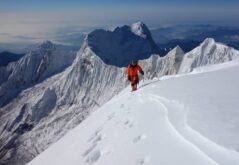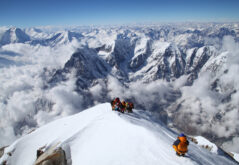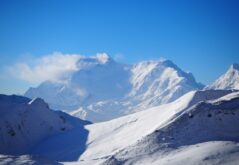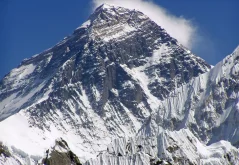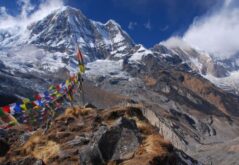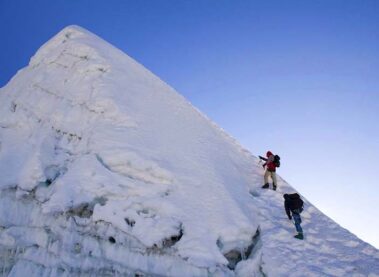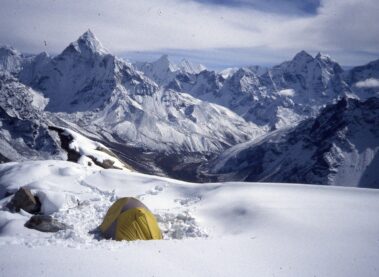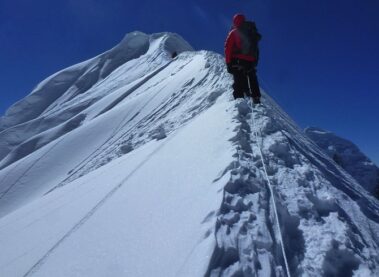
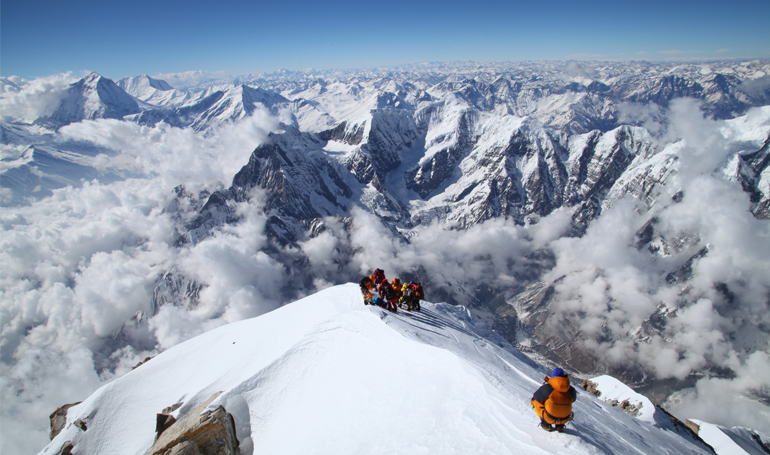
Annapurna Expedition
TripOverview
Annapurna I is the eighth-highest mountain in Nepal and the tenth-highest mountain in the world. Mount Annapurna lies in the Annapurna mountain range in the Gandaki province of Nepal. Annually a lot of people do Annapurna Expedition for its challenging and beautiful surroundings.
Maurice Herzog led the first Expedition team to the summit of Mount Annapurna through the north face of the mountain in 1950 AD. On this day Maurice and his friends made history by climbing the most difficult mountains in the world. It was not until 1970. Annapurna Expedition has submitted again from its Northwest Ridge.
Similarly, the Annapurna massif contains six major peaks, Annapurna I (8091m/26,545ft) II(7937m/26,040ft) III(7555m/24,786ft) IV (7525m/24,688ft) Gangapurna (7455m/24,457ft) Annapurna South (7219m/23,684ft).
Find More: Annapurna Expedition in Autumn Season
Likewise, the trails for this Expedition are very challenging for rookie trekkers or climbers. Historically, the Annapurna peaks have been among the world’s most disloyal mountains to climb. So, you have to be very careful doing this expedition. Although the Annapurna expedition is less Challenging than other expeditions such as Everest and Annapurna, it has its own difficulties.
Similarly, for doing the Annapurna Expedition it is safer to do it from the south side. Likewise, Annapurna Expedition is less challenging from the south side. A lot of passionate climbers prefer climbing the Annapurna Expedition from the south side.
Annapurna Base Camp
Annapurna Base Camp is located at an altitude of 4200m. A lot of climbers spend most of their time at the Annapurna Base Camp during this Expedition. So, naturally, it becomes their home away from home. Therefore, it is very important for us to set up a suitable camping and resting environment.
Similarly, We set up our camp at walking distance between meeting points of different groups and the Annapurna viewing positions. So, you can fully enjoy the beauty of the surroundings and your stay at the Annapurna Base Camp.
Furthermore, we provide your visitor with a personal, dining tent, a common area, a shower tent, and a toilet tent. In addition, when you arrive at the base camp, it will already be fully established, with hot beverages and snacks available immediately. Waiting for you upon your arrival will be your base camp staff and high-altitude climbing Sherpa.
In addition, before we head for your Expedition we will worship god(do puja) according to Nepali tradition for good luck and success. So, you should not miss this ceremony before the Expedition.
Who can do Annapurna Expedition?
The Annapurna Expedition is extremely difficult and challenging. So, you should be prepared for the challenge. Similarly, you should not have any health issues. So, if you have some health issues then you cannot do this trek. Your heart and lungs should be perfectly fine if you want to enjoy and complete this trek and climb. Similarly, you should not have any blood-related diseases.
Furthermore, you should be physically fit for this Expedition. In addition, jogging and running before the Expedition is helpful because it helps you with stability and improves your stamina. The trails of the Annapurna Expedition are long and steep so you have to take these things into consideration and prepare accordingly. Otherwise, the Annapurna Expedition is going to be troublesome.
Important Article: How to Handle Altitude sickness while climbing in Nepal
Why Annapurna Expedition
During this expedition, you will see a lot of beautiful things. You will be in love with the nature of the place. Similarly, you will see a magnificent view of the Himalayas. Likewise, you will get a stunning view of Mount Annapurna(I, II, III, IV) and Dhaulagiri.
In addition, you will get to experience the abundant flora and fauna of the place. Furthermore, you will get to the summit of the eighth-highest mountain in Nepal and the tenth-highest mountain in the world. Similarly, you will get to interact with the locals and know their traditions and culture. In addition, you will get to experience the biodiversity of Nepal.
Highlights of the Annapurna Expedition
- Observe one of the most remote and beautiful areas in Nepal.
- Explore the diversity of flora and fauna.
- Experience rich local culture.
- View the 10th-highest mountain in the world
- Get a magnificent view of Mount Dhaulagiri and Annapurna.
- Observe the most exciting expedition in Nepal.
- Experience technically and physiologically challenging routes
- Get safe, qualified, and experienced staff.
- Obtain trained Sherpa climbing guides for the Expedition.
TripItinerary
Arrive at Kathmandu [1345m/4411ft] and transfer to Hotel.
Today is the first day of your expedition. So, today your airport arrival representative will pick you up and you will either be at hotel Yak and Yeti or similar hotel accommodation in Kathmandu. Where the hotel staff helps you settle.
Preparation and briefings
On the second day, you will be doing the necessary preparation for the journey and you will be given a briefing at the department of tourism and start doing the necessary shopping for the climb after all the work at the department. Similarly, you can do last-minute shopping and get every essential thing to you for the expedition. Likewise, visit some of the famous temples of Kathmandu.
Drive from Kathmandu to Pokhara (950m/3,116ft)
On day 3 we will leave Kathmandu early in the morning to Pokhara at an altitude of 950m. You will travel almost 125 miles through Prithivi Highway. Similarly, during this journey, you will see beautiful sceneries of the surrounding and beautiful hills. Furthermore, you will rest at a comfortable lodge for the night in Pokhara
Trek or Drive from Pokhara to Tatopani (1110m/3,641ft)
On day 4 we continue our driving journey from Pokhara to Tatopani at an altitude of 1110m. Similarly, during this journey, you will see different rivers on the way. Likewise, you will see the beautiful hills of Tatopani which will add to your Expedition journey. Furthermore, this journey takes around 5 hours. In addition, after we reach Tatopani we will rest in a comfortable lodge and enjoy their hospitality and tasty local food.
Trek from Tatopani and Lete (2300m/7,546ft)
On day 5 we finally start our trekking journey from Tatopani. This is the first day of our trekking journey. So, make sure that you are ready for the challenge. Similarly, the trek from Tatopani to Lete is mostly uphill so it will challenge your stamina and stability. Furthermore, make sure you properly hydrate yourself. As this trek is done at a high altitude you might fall victim to altitude sickness, therefore, acclimatize yourself properly between the journey.
Trek from Lete to Jungle camp (2900m/9,515ft)
On day 6 we continue our trekking journey from Lete to Jungle Camp. During this trek to Jungle Camp from Lete, you will see various flora and fauna of the place. Similarly, while trekking here you will be in love with nature. Likewise, this trek is mostly uphill so you have to be careful during this journey. In addition, after reaching Jungle Camp you will do Camping Accommodation and we will rest there for the night after a healthy dinner.
Trek from Jungle camp to Miristi Khola(4260m/13976ft).
After a good night’s sleep at Jungle Camp. We will continue our trekking journey to Miristi Khola after a healthy breakfast in the camp. Likewise, the trekking from Jungle Camp to Miristi Khola is mostly uphill and winding but the fresh air after reaching Miristi Khola will make you forget all your hardships during the voyage. Similarly, the blue color of the river will add up to your Expedition. Similarly, after reaching Miristi Khola(River) you can go fishing and we will set up our camp there and rest for the night after dinner
Trek from Miristi Khola to Annapurna-BC (4200m/13,780ft)
Similarly, after having a healthy breakfast we will continue our trekking journey. Likewise, this is going to be the last trekking voyage before we reach Annapurna Base Camp at an altitude of 4200m. Furthermore, after we reach Annapurna Base Camp we will set up our camp and laze for the day.
Climb Annapurna I (8091m/26545ft.)
From day 9 to day 38 we will climb Annapurna I. Similarly, during this period you will get closer to your climbing friends and after the climb is over we will have a success party on day 39.
Trek from Annapurna Base camp to Miristi Khola(4260m/13,976ft)
After a successful summit of Mount Annapurna, we will clean the base camp and return to Miristi Khola at an altitude of 4260m. Similarly, after we reach Miristi Khola we will camp there for the night.
Trek from Miristi Khola to Jungle Camp (2900m/9,515ft)
On day 40 we will trek from Miristi Khola to Jungle Camp in the same way we did to ascend at an altitude of 2900m. But, the way is mostly a downhill climb. While on this journey you will see the beauty of Jungle Camp from above which is eye-catching. The beauty of the forest is mesmerizing. Furthermore, after we reach Jungle Camp we will camp there for the night.
Trek Jungle camp to Lete (2300m/7,546ft)
On day 41 After having our breakfast, we’ll return to the trail that starts with a level walk for a good few minutes. From the same trail, we used to ascend. Similarly, most of the trekking is a downhill climb from Jungle Camp at an altitude of 2300m. Likewise, after we reach Lete we will set up our camp and relax for the night.
Drive from Lete to Tatopani (1110m/3,641ft)
On day 42 we will catch a bus early in the morning and head to Tatopani. Similarly, during your return journey from Lete to Tatopani, we will see beautiful hills. We will see different domesticated animals, abundant flora, and fauna. After we reach Tatopani we will explore the famous hot spring facility of Nepal. Furthermore, this hot spring is the reason that Tatopani got its name. Tatopani means hot water. After we finish exploring the hot spring we will rest at a comfortable tea house and enjoy their hospitality and food.
Trek from Tatopani to Beni (830m/2723ft)Drive to Kathmandu
This is the third last day of your expedition and the last day of your trekking journey. Similarly, on this day we will start our trek early in the morning from Tatopani to Beni. After we reach Beni we will head toward Kathmandu. In addition, you will travel in a comfortable tourist mini bus enjoying the beauty of the surroundings. Likewise, after you reach Kathmandu you will rest at a 3-star comfortable hotel where the staff will help you settle.
Free day; Farewell-Celebration dinner with culture program in the Evening.
Today is the second last day of your trek. Furthermore, this is a free day so you can visit Kathmandu City. Similarly, you will have a farewell celebration dinner with a culture program in the evening. Where you will experience different cultural foods with some cultural traditions. Similarly, you can share your experience with your colleague about your Expedition journey.
Transfer to the airport for final departure.
Today is the last day of your expedition. So, your airport departure representative will leave you at the airport for your final departure. Similarly, until your flight has not arrived you can visit Kathmandu city.
IncludedExcluded
Whats Included
- Arrival & Departure: Airport - Hotel transfers – Airport (Pick Up and Drop).
- Hotel Accommodation in Kathmandu: 3 nights hotel in Kathmandu (3 Star Category) on bed & breakfast Basis- Sharing Twin Bed Room.
- Welcome Dinner: One Welcome Dinner in a tourist standard restaurant in Kathmandu with Office’s Staff.
- Permit All necessary paperwork: Pumori climbing Permit from NMA, Sagarmatha National Park entry permit, TIMS CARD & Pasang Lhamu Rural Municipality entry fee.
- Garbage Management: Garbage Deposit fees.
- Insurance: Medical & Emergency rescue Insurance for all involved Nepalese staff during the trek and climbing.
- Map: Trekking and climbing map.
- Land Transportation as per itinerary
- Climbing Stuffs Transportation: Necessary all equipment Transportation for all Members and Staffs from Kathmandu to Pokhara (by vehicle) and to Base camp (by Porters)–While returning: Base camp to Pokhara (by porters) and Pokhara to Kathmandu (by vehicle).
- Member Luggage: Up to 25 Kg per member for personal baggage during the trek carried by porters.
- Food and Lodging: 3 Food 3 meals a day (BDL; including tea and coffee) along with accessible accommodation at Hotel/Lodge during the trek.
- Drinking: 2 liters of boiled water to carry on thermos per day per member.
- Porter: Porters (1 member: 1 Porter) during the trek.
- Climbing Sherpa: Veteran and Government Licensed Climbing Guide.
- Climbing Sherpa Salary & Allowance: Climbing Sherpa Salary, Equipment, Food, and Clothing.
- Staff Salary and allowance: All Nepalese staff & porters daily wages, salary, equipment, foods & clothing.
- Oxygen Bottle (O2): Oxygen bottles will be in stock at base camp in case of an emergency (with appropriate charge).
- High camp service: Necessary cooking gas, cooking pot for members, high altitude tent (sharing basis), high food for members, Sherpa, and climbing crews. Group climbing gears, fixed and dynamic rope during the climbing period as required.
- Light: Necessary light at all tents. * if required.
- Guide: Government licensed Guide (English speaking) during the trek and sight-seeing in Kathmandu valley.
- Valley Sightseeing: Sightseeing in Kathmandu Valley [Swoyambhu (Monkey Temple) and Kathmandu Durbar Square] by a professional guide.
- Comprehensive Medical kit.
- Certificate: Annapurna climbing certificate issued by Nepal Mountaineering Association (after climbing the Annapurna successfully).
Whats Excluded
- Air Fare: International flight airfare (from and to Kathmandu).
- Nepal entry Visa fee: Nepali Visa fee is USD 60 per person for 30 days and to be applied for 60 days is USD 120.
- Lunch & Dinner: Lunch & dinner during the stay in Kathmandu (also in case of early return from Trekking / Expedition than the scheduled itinerary).
- Extra night in Kathmandu: Extra nights’ accommodation in Kathmandu. In case of early arrival or late departure, early return from Trekking / Expedition (due to any reason) than the scheduled itinerary.
- Insurance: Travel and high altitude insurance, accident, helicopter medical & emergency evacuation. *Mandatory
- Rescue Evacuation: Medical and emergency rescue evacuation costs if required. (Rescue, Repatriation, Helicopter, Medication, Medical Tests and Hospitalization costs.)
- Personal Expenses: Telephone, Internet, Toiletries, battery recharge, hot shower, laundry, any Alcoholic beverages (during the trek and in Kathmandu but we will serve soft drinks for members in base camp)
- Personal Equipment: Clothing, Packing Items or Bags, Personal Medical Kit, Personal Trekking /Climbing Gears.
- Toiletries: Soaps, shampoos, toilet and tissue papers, toothpaste, and other items used to keep yourself clean.
- Filming: Special Filming, Camera, and Drone permit fee.
- Internet Service: Not included during the trek.
- USD 25 for an extra porter per day (If extra porter demanded).
- Summit Bonus: Summit bonus for climbing Sherpa.
- Tips: Tips for Basecamp and other staff.
- Extra: Any other services or activities, which are not mentioned in the itinerary.
- Any other item not listed in the “Cost Includes” section.
UsefulInfo
Best Time for Annapurna Expedition
Annapurna Expedition is a wonderful journey to do any season. But, the ideal time to do this Expedition is between September to November. If not, you can do this expedition in the spring and autumn seasons. During this time of the year, you will find an ideal climate for the expedition. Similarly, April is the warmest month of the year in Nepal. So, you can do this trek and climb at this time of the year. During this time of the year, the climate is moderately stable and suitable. Therefore, it can be very helpful for people who want to enjoy the scenery and the surroundings. In addition, if you travel here during this time then you can enjoy a stunning view of Annapurna and Annapurna peaks.
The Difficulty of Annapurna Expedition
There can be a lot of difficulties if you climb at a higher altitude. Similarly, the expedition to Mount Annapurna is very troublesome. Likewise, you can face a lot of difficulties climbing here. The most common difficulty that you are going to face while climbing here is high altitude sickness. Altitude sickness is a condition when your body has shortness of breath and dizziness. Similarly, if you travel here during one season then there might be a shortage of suitable porters and accommodation facilities. Likewise, if you travel here during the winter season then you might find slippery trails which can hamper your journey. In addition, if you do this expedition in the rainy seasons then the climate and weather can affect your journey.
Travel Insurance Requirement
You must have your travel insurance with you. So, make sure your travel insurance company has covered all your safety measures. Make sure that the insurance company provides you with every facility. Because it has a lot of benefits during the expedition. Therefore, make sure your travel insurance covers your injury, medical expenses, repatriation expenses, rescue mission, loss of property, etc. But, most importantly make sure your travel insurance is not expired. Furthermore, make sure that your Insurance policy has covered your 4000m climbing and adventure policy. Otherwise, it will be difficult for us to cooperate. Therefore, make sure you have it with you.
Meals and Accommodation for Annapurna Expedition
We provide a wide range of food and accommodation to our visitors at the Annapurna Expedition. Similarly, we provide a suitable and peaceful environment for our visitors for yoga and meditation. Likewise, at the routes of the Annapurna Expedition, we provide a wide range of comfortable hotel lodges and accommodation facilities. As most of the accommodation facilities are run by the locals you will get a chance to experience quality local food and hospitality. In addition, the locals there also provide western foods though it’s a bit expensive compared to the local meals. Local dishes are less pricey because they prepare them with their local farm produce and spices. Whereas, most of the ingredients for western foods are imported from cities. So, western foods are slightly expensive. Furthermore, as you go higher up the altitude the price of the meals also increases.
Fitness and Experience Requirement for Annapurna Expedition
Climbing at a higher altitude requires you to be mentally and physically fit. Similarly, if you can walk for around 6-7 hours with a light backpack then this trek and climb are very fruitful for you. This expedition is for around 45 days which is suitable for busy people. Similarly, you should not have any health issues. So, if you have some health issues then you cannot do this expedition. Your heart and lungs should be perfectly fine if you want to enjoy and complete this climb. Similarly, you should not have any blood-related diseases. However, you should not be that experience for the climb. But, you should have a little knowledge about the Expedition. You should not go there blindly.
Climate and Weather for Annapurna Expedition
Climate and weather are important factors to consider for your trek. Similarly, your trek and climb success rate solely depends on this. So, it is very important to consider before heading on the trek and expedition. The spring and autumn season is the best time to do the expedition. During this time of the year, the weather is very pleasant and warm. However, it gets cold at night. It can probably show above 4000m altitudes. However, the climate of the Himalayas is unpredictable. It is usually warm during the day and cold during the night. So, you should have a reliable sleeping bag with you. But, it is quite warm if there is sunshine. Similarly, if there is sunshine during the expedition then you can fully enjoy the view of the surroundings. Likewise, you will travel in clear visibility.
Safety and Security for Annapurna Expedition
The Safety and Security of our trekkers and climbers are very important for us. Similarly, while trekking and climbing in Annapurna Expedition we carefully check every route for the trek. So, don’t worry you will be safe with us. Similarly, we also take good care of the belongings of our trekkers on the lodges and during the trek as well. Therefore, you feel free and fully enjoy yourself during the expedition, you should not worry about yourself and your belongings. We fully take care of that.
Frequently AskedQuestions
When is the best time for the Annapurna Expedition?
Autumn (September, October, November) and spring (March, April, May) are suitable for Annapurna Climbing. However, it is possible in monsoon seasons too.
How difficult is the Annapurna Expedition?
How much will it cost to climb the Annapurna Expedition?
Can you climb the Annapurna Expedition alone?
Do I need a climbing permit for the Annapurna Expedition?
Can you have altitude sickness on the Annapurna Expedition?
What is the food price at Annapurna Expedition?
How many hours do I need to walk per day?
Can I carry children on the Annapurna Expedition?
Is the Annapurna Expedition trail crowded?
What will happen If I get sick during the Annapurna Expedition?
Is charging my phones and batteries possible in the route of the Annapurna Expedition?
Can I buy or rent gear while trekking?
What should be the weight of a backpack?
CustomersReview
Margaret Cook BulgariaI never thought that my Annapurna Expedition would be this good. I am grateful to Peak Climbing that they made my visit to the Annapurna region fruitful. Before visiting Peak Climbing I visited the different climbing companies. But, I did not find satisfaction. Finally, the facilities of Great Adventure Treks and Expedition piqued my interest and this was the best decision I made for my climbing career. The hotel and lodge facilities that they provide are very suitable for a climber like me. Similarly, the accommodation facilities are safe as well. Thank you to all the members at Great Adventure Treks and Expedition for making my journey so memorable.
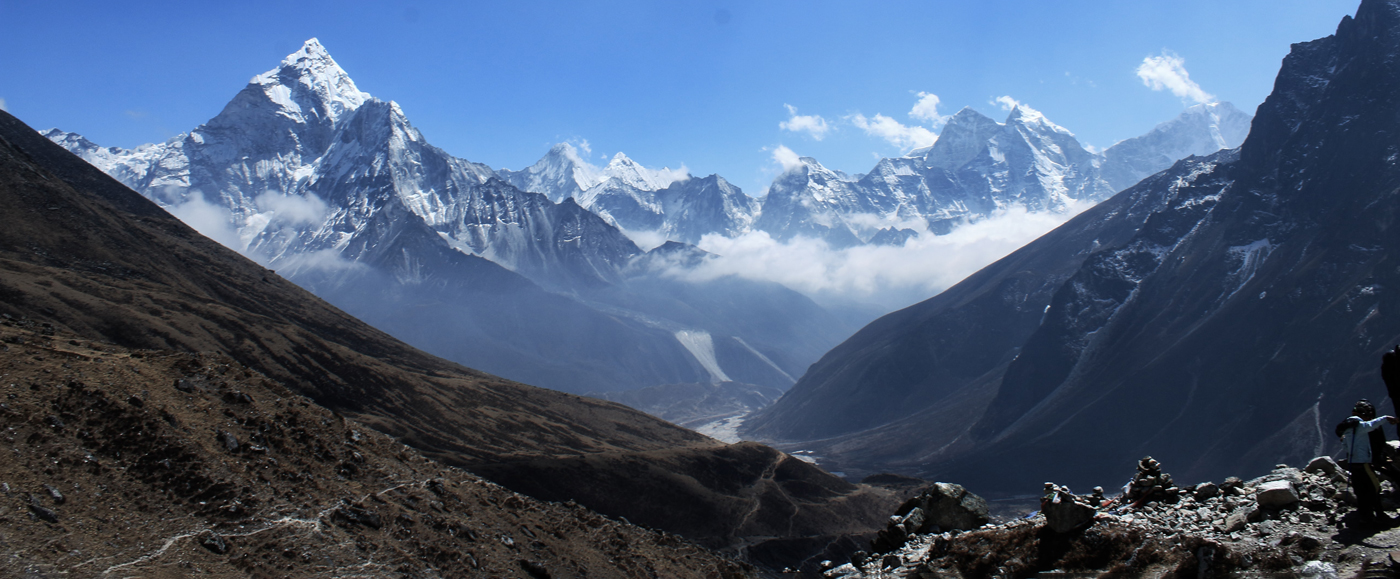
Need Assistance
Need Help? Call us or drop a message. Our agent will be in touch shortly.

